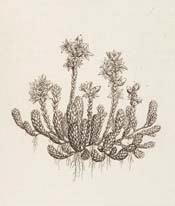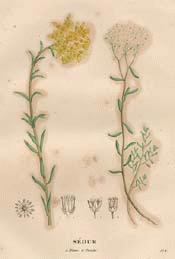
StonecropsSTONECROP, WHITE
Botanical: Sedum album
---Synonym---Small Houseleek (Culpepper).
|

|
(Sedum acre) |
Botanical: Sedum acre
Family: N.O. Crassulaceae
---Synonyms---Biting Stonecrop. Wallpepper. Golden Moss. Wall Ginger. Bird Bread. Prick Madam. Gold Chain. Creeping Tom. Mousetail. Jack-of-the-Buttery.
(French) Pain d'oiseau.
---Part Used---Herb.
The Common or Biting Stonecrop is the commonest of the Stonecrops, growing freely upon walls and cottage roofs, on rocks and in sandy places, especially near the sea, forming tufts or cushions, 3 to 10 inches across, which in June and July are a mass of golden blossom, but its flowering season is very soon over.
The root is perennial and very fibrous, its minute threads penetrating into the smallest crevices. The stalks are numerous, many of them trailing and flowerless, others erect - generally 3 to 5 inches high - bearing the clusters of flowers. When growing among other foliage, or on rockwork, the flowerstalks are often drawn up to some height, at other times much dwarfed. They branch and are clothed with numerous leaves. The little upright and very succulent leaves that closely overlap on the flowerless stems are a distinguishing characteristic from the other yellowflowering species of Sedum; they are so fleshy as to be almost round. The starlike flowers are of a brilliant yellow colour, the five sepals small and inconspicuous, but the five petals, spreading and acutely pointed, are a striking feature. There are ten stamens, with anthers the same tint as the petals.
The pungency of the leaves has obtained for the plant its specific name of acre, and the popular English name of Wallpepper and Wall Ginger. Gerard tells us it was known in his day as Mousetail, or Jack of the Butterie. As regards the latter name, Dr. Fernie says: 'this and the Sedums album and reflexum were ingredients in a famous worm-expelling medicine or "theriac" (treacle), and "Jack of the Buttery" is a corruption of Bot. theriaque.'
De Lobel called it vermicularis, partly - we are told - from the grub-like shape of the leaves, and partly from its medical efficacy as a vermifuge.
- Some old writers considered this species to possess considerable virtues, but others, from the durability of its acrimony and the violence of its operation, have thought it unsafe to be administered. Culpepper tells us:
- 'Its qualities are directly opposite to the other Sedums, and more apt to raise inflammations than to cure them; it ought not to be put into any ointment, nor any other medicine.'
Pliny recommends it as a means of procuring sleep, for which purpose he says it must be wrapped in a black cloth and placed under the pillow of the patient, without his knowing it, otherwise it will not be effectual.
[Top] [Top of Stonecrop, Common]
STONECROP, CROOKED YELLOW
Botanical: Sedum reflexum
Family: N.O. Crassulaceae
---Synonym---Stonecrop Houseleek.
---Parts Used---Leaves, young shoots.
The Stonecrop Houseleek of the old herbalists goes now by the name of Crooked Yellow Stonecrop.
---Description---It is not considered truly indigenous, though often found on rocks, old walls, house-tops, and sometimes on dry banks, in many parts of the British Isles. The slender but tough stems, tinged with pink, are elongated, lying on the ground, sending up numerous ascending, short, leafy, barren shoots and erect, and somewhat flexuous flowering stems, 9 inches to 1 foot high, clothed with spreading and reflexed leaves, which are cylindrical and pointed, 1/2 to 3/4 inch long, spurred at their bases. The leaves are distant towards the lower ends of the barren shoots, but crowded towards the apex, forming a kind of tuft: they are only curved back, or reflexed, on the flowering stems. This Stonecrop also blossoms in July and August: the flowers are in terminal cymes as in the previous species, but are bright yellow.
In Holland, the leaves and young shoots of this species are used for salad.
Culpepper considered that as 'it is more frequent than the white stonecrop, flowering at the same time, it may very well supply its place.' He goes on to tell us that the Houseleek, 'though not given inwardly, yet is recommended by some to quench thirst in fever.' Mixed with posset drink, 3 OZ. of the juice of this and Persicaria maculata, boiled to the consistence of a julep, are recommended to allay the heat of inflammation.
[Top] [Top of Stonecrop, Crooked Yellow]
STONECROP, ORPINE
Botanical: Sedum telephium
Family: N.O. Crassulaceae
---Synonyms---Live Long. Life Everlasting.
(French) Herbe aux charpentiers.
---Parts Used---Whole plant, leaves.
The Orpine, the largest British species of this genus, is readily distinguished from most of the other plants allied to it by its large, broad, flattened leaves and terminal heads of pinkish flowers, being the only British species with flat leaves.
It has a wide distribution: in warmer countries it is a mountain plant. Lindley gives its true habitat as mountainous woods, and Cesalpinus, an early Italian botanist, calls it Crassula montana, but in this country it grows freely in lower situations. It is probable that it was originally an introduced plant, though it is now not uncommonly found in hedgebanks on shady sides of fields and in woods, though probably escaped from cultivation in many of its localities. In its wild state, the plant' is from 1 to 2 feet high, though in gardens it may attain as much as 3 feet.
The root-stock is perennial, large and fleshy, producing small parsnip-shaped tubers, with a whitish-grey rind, containing a considerable store of nourishment. The stalks are numerous, erect, unbranched, round and solid, generally of a reddish tint, spotted and streaked with a deeper red above. The flat, fleshy leaves, bluish-green in colour, are numerous, placed alternately on the stem at very short intervals, and coarsely toothed. The upper leaves are rounded at their bases and without foot-stalks, the lower ones taper at the base to a short stalk, being almost wedge-shaped; they are largest and closest together about the middle of the stem, where they are 1 1/2 to 3 inches long.
The flowers are in compact heads at the top of the stems, forming a brilliant mass of crimson, in most cases, though sometimes whitish, suffused with dull purplish rose. They are spreading and acutely pointed, three times as long as the calyx. In their centre are ten conspicuous stamens, with reddish anthers, and the ovaries they surround are also reddish.
The whole plant is smooth and somewhat shiny. It flowers in July and seeds in August.
The specific name is derived from Telephus, the son of Hercules, who is said to have discovered its virtues. Its most familiar English name, Orpine, is derived from Auripigmentum, the gold-coloured pigment, called Orpiment, or Orpin, a yellow sulphuret of the metal arsenic. This name, which might have been appropriate enough for the brilliant yellow flowers of the last two species described, is quite out of place applied to the crimson blossoms of this Sedum.
Its tenacity of life has earned it the name of 'Live Long' and 'Life Everlasting,' the length of time it will continue fresh after being gathered being remarkable. It will live a long time if uprooted and hung up in a room without earth or water, subsisting on the store of nourishment in its fleshy leaves and swollen roots.
[Top] [Top of Stonecrop, Orpine]
---Constituents---The whole plant is mucilaginous and slightly astringent. It contains lime, sulphur, ammonia and probably mercury.
The leaves have sometimes been used as a salad, like the other Sedums, but though sheep and goats eat it, horses will refuse it.
---Medicinal Action and Uses---It has been used as a popular remedy for diarrhoea. The leaves are boiled in milk, and a large teacupful of the decoction taken three or four times a day is said also to stimulate the action of the kidneys, and to be serviceable for piles and haemorrhages. Orpine has also an anticancerous reputation.
- Culpepper stated that it was seldom used internally in his days, but that the celebrated German herbalist, Tragus, considered its distilled water -
- 'profitable for gnawings or excoriation in the stomach or bowels, for ulcers in the lungs, liver or other inward parts and cures those diseases, being drunk for days together,'
- and that the root has the same action, even stronger. He says that it is:
- 'used outwardly to cool inflammations upon any hurt or wound, and easeth the pain of them; as also to heal scaldings and burnings, the juice thereof being beaten with some green salad oil and anointed. The leaf bruised and laid to any green wound in the head or legs doth heal them quickly, and being bound to the throat cureth the quinsy; and it reduceth ruptures. If you make the juice into a syrup with honey or sugar, you may safely take a spoonful or two at a time for sore throat and quinsy.'
STONECROP, VIRGINIAN
Botanical: Penthorum sedoides (LINN.)
Family: N.O. Crassulaceae
---Synonyms---Ditch Stonecrop. Penthorum.
---Part Used---Herb.
The Virginian Stonecrop is a native of America.
---Description---It is a biennial, with stems about a foot high, on which the leaves are placed on alternate sides, on short stalks. They are oblong, 2 to 3 inches long and about a third as broad, smooth and thin, the apex pointed and the margins finely toothed. The flowers are small and greenish, on short flower-stalks, in rows along the upper sides of the branches of the terminal cyme: there are five very small petals and five sepals, and the ovary is five-cleft and five-celled, surrounded by ten stamens with filaments twice as long as the calyx. The genus Penthorum differs from the genus Sedum, in having no nectaries in its flowers.
This plant has of late attracted much notice, especially in America, as a remedy for catarrh, catarrhal inflammation of the larynx, chronic bronchitis, with increased secretion of mucus and catarrhal affections of the stomach and bowels. It has also been employed with success in the treatment of diarrhoea, haemorrhoids and infantile cholera.
It is demulcent, laxative and somewhat astringent in its action. A fluid extract is prepared from the whole herb and administered in doses of from 10 to 20 drops. It has a slightly astringent taste.
[Top] [Top of Stonecrop, Virginian]
---Other Species---
Among other species of Sedum are the HAIRY STONECROP (Sedum villosum), frequent in Scotland and the North of England, a small species with viscid stems and leaves and pinkish-white flowers. The THICK-LEAVED STONECROP (S. dasyphyllum), also a small species, but very rare, distinguished from the preceding by its fleshy, almost globular leaves, viscid flower-stalks and blunt petals. Other British species belonging to this group are: TASTELESS YELLOW STONECROP (S. sexangulare), distinguished from S. acre by its leaves, which are six in a whorl, growing in Greenwich Park, the Isle of Sheppey and a few other places. ST. VINCENT S ROCK STONECROP (S. rupestre), a species allied to S. reflexum, with slightly flattened leaves, which grow five in a whorl, found on St. Vincent's Rocks and other limestone cliffs, rare; and WELSH STONECROP (S. Fosterianum), another species allied to S. reflexum, with leaves flattened at the base and compact cymes of flowers - which grows on the rocks in Wales and Shropshire.
See:
HOUSELEEK
KIDNEYWORT
[Top]
© Copyright Protected 1995-2004 botanical.com

